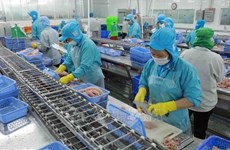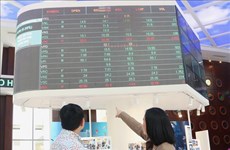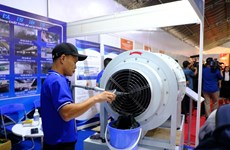Vietnam-Japan trade expected to surge in 2017
 Japanese Prime Minister Shinzo Abe and his wife arrive in Vietnam for a visit in mid-January, 2017. (Source: VNA)
Japanese Prime Minister Shinzo Abe and his wife arrive in Vietnam for a visit in mid-January, 2017. (Source: VNA)Hanoi (VNA) – The Vietnam-Japan trade is expected to reach a new height in 2017 as
the two countries have agreed on many measures to boost the trade exchange, it
was agreed at a recent seminar on promoting trade with Japan held by the
Ministry of Industry and Trade (MoIT).
Vu Cuong, deputy
head of East Asia division of the Asia Pacific Market Department under the
MoIT, said a series of visits made by leaders of the two countries in early
2017 reflected the two sides’ resolve to boost ties.
Japanese Prime
Minister Shinzo Abe visited Vietnam in mid-January and Japanese Emperor is
expected to travel to Vietnam in mid-February, while Vietnamese leaders also
have plans to visit Japan in March.
Besides good diplomatic
relationship, trade experts urged the business community to seize opportunities
brought about by the Vietnam-Japan Economic Partnership Agreement (VJEPA).
Cuong underlined the tax
reduction roadmap stipulated in the VJEPA, under which import tax will be cut
to 2.8 percent in 2018 and at least 86 percent of agri-forestry-seafood
products and 97 percent of Vietnamese industrial products will enjoy
preferential tax rates in the Japanese market.
Meanwhile, average taxes on Japan’s
goods imported into Vietnam will be reduced to seven percent in 2018.
Within 10 years, the two
countries will complete the roadmap for tax reduction to form a bilateral free
trade zone in which 94.53 percent of Vietnam’s export turnover and 87.6 percent
of Japan’s will be exempted from import tax.
However, according to Le An
Hai, deputy head of the MoIT’s Asia Pacific Market Department, Vietnamese
enterprises have taken advantage of just 40 percent of opportunities offered by
the VJEPA.
Hai advised enterprises to
invest in quality of goods and boost promotion activities to tap the Japanese
market.
Nguyen Trung
Dung, Vietnam’s commercial counsellor in Japan, said the structure of
Vietnamese and Japanese goods are complementary and not competitive against
each other.
Japan mainly
imports seafood, garments, footwear, and processed food while Vietnam imports
machineries, equipment, technology and materials for production from Japan.
According to
data from the Ministry of Industry and Trade (MoIT), Vietnam’s export to Japan
in the first 11 months of 2016 was 13.3 billion USD, up 3.1 percent on a yearly
basis, making Japan Vietnam’s second largest export market behind the United
States.-VNA













